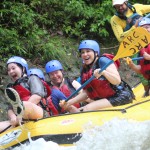Ever since the Bill Murray movie, Groundhog Day has become an icon for the repetitive patterns in which we find ourselves, patterns which must be improved incrementally over time, because they are so much a part of how we operate.
On Sunday, I had my first true #cakefail in a long time. It was my daughter’s tenth birthday, and the four-tier raspberry chocolate cake went wrong in almost every way possible. The layers became stuck in the pan, creating a crumby and uneven exterior, and making it almost impossible to frost. I can’t even accurately describe the raspberry jam filling disaster. To try to cover everything, I piped on a thick layer of buttercream, which very soon began peeling back from the cake in large swathes. Once I realized how bad things were, 30 minutes before the party, and me in my pajamas, my laughter dissolved into tears.
This is my pattern: Taking my experiences, knowledge and skills, grabbing onto some idea that catches my imagination, tinkering, and creating a potentially dire situation at the last possible moment which sends me into an anxiety spiral.
I am finding that this pattern is a stressful one when you all of a sudden teach six different sections of English Language Learners with six different sets of standards, and switch from high school to middle school in the final weeks of summer. Yup. Without ever having taught English Language Development before.
When I decided to take this exciting leap, thinking of how great it would be to really get to know a small group of students who needed me and help guide them to success, I remembered: Wait a minute! Maybe there is a set of textbooks or a “system,” a curriculum I can rely on to get started, the way Read180 was used for my reading students in high school. Most of the elementary teachers I knew relied greatly on “programs” or textbook adoptions, and it made sense to me because they have to plan for so many subjects*. Having come out of high school English, where novel is queen, and research is king, in the past I could not wrap my head around teaching “from the textbook.” But I could see the appeal the more I considered the reality of teaching six different sections of ELD with only limited professional knowledge of the methods or standards. Not to mention 7th grade impulsiveness.
However, although the previous teacher left me lots of well-organized sets of books, there was no official textbook adoption or program that could guide me. I was told there were “resources,” mostly online. My shifting groups of students, and the way that ELD is strictly split into time allocations for reading, writing, conversation/vocabulary and grammar made it hard to use textbooks that integrated these language processes the way I would have in a regular secondary English classroom. I needed a reading program, a writing program, a speaking/listening and vocabulary program, and a grammar program. But I was left to develop those programs using all my “resources.”
I won’t lie: Most of my insides did a happy dance. The past many years of increasing movement toward standardization and lock-step teaching (in every school and district that I know of) has limited what used to be one of the most enjoyable parts of teaching for me, creating ideas for projects and units. I still enjoy developing curriculum with my colleagues, but the collaborations and planning conversations have changed in nature since when I started teaching. Here, I was given the chance to create and develop as much as I wanted to, consulting with experienced mentors, and being guided by the standards, but otherwise given free rein. Woo-hoo!
However, I have to admit, there have been a few #cakefails in the classroom. And yet I want to do so well! But the reality is that with so many variables, and so incredibly much to learn, and with me and my big ideas… not every day will work out. The adventure is fun, though, and I am free to meet my students where they are. So as long as I assess frequently, and make sure that what I offer them is mostly comprehensible, we should be okay. With evaluation season approaching, I hope that there is space in the scores for a few #cakefails. Because to be honest, I don’t want a program. I want to share ideas with other professionals, be given plenty of resources, and be provided time to learn and develop. Only like this can I turn an exasperating pattern into professional expertise. It is only in moments of sheer panic that I wish there was a textbook. “All right, students! Open to page 57…”
*I have to note here that the vast majority of elementary school teachers do not stop with the “program.” They learn it inside and out and magically transform it into something that they and their students can own. I don’t mean to imply that elementary teachers simply teach “from the textbook” but that it is a necessary and handy tool.










Comments 3
Great post! I also do a happy dance when I am able to express my creativity through my lesson planning and teaching. It is one of my favorite parts of this career, especially since I don’t have any other creativity. Every cake I make would be a #cakefail. The lock-step teaching movement has impacted me a lot this year as I am dealing with a new Language Arts curriculum that must be used with the f word – “fidelity.” Thanks for your post.
I love this post, and I love #cakefails, too! the cakefails of life teach me the most; plus, the metaphoric cake usually tastes really good, even if it looks messy.
In a weird way, I kind of want my teaching to be allowed to be messy, as long as it tastes good. You know?